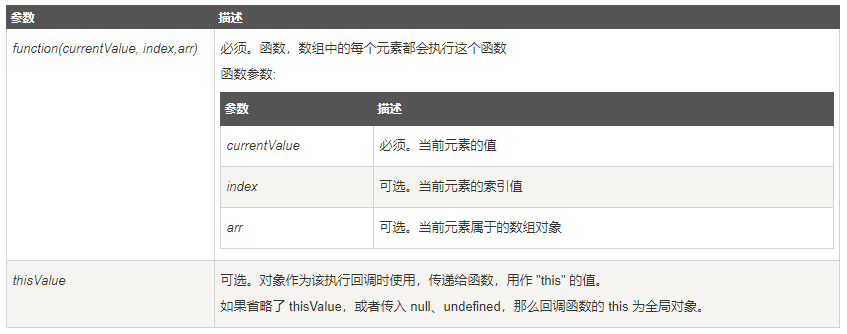js——数组/对象常用方法总结
参考:http://www.mamicode.com/info-detail-2653981.html
https://blog.csdn.net/w390058785/article/details/80522383
1. filter
filter() 方法创建一个新的数组,新数组中的元素是通过检查指定数组中符合条件的所有元素。
注意: filter() 不会对空数组进行检测。
注意: filter() 不会改变原始数组。
语法:
array.filter(function(currentValue,index,arr), thisValue)
参数:

例:
let ages = [32, 33, 16, 40]; let arr = ages.filter(item => { return item >= 18 }); console.log(arr); //[32,33,40]
2. map
map() 方法返回一个新数组,数组中的元素为原始数组元素调用函数处理后的值。
map() 方法按照原始数组元素顺序依次处理元素。
注意: map() 不会对空数组进行检测。
注意: map() 不会改变原始数组。
语法:
array.map(function(currentValue,index,arr), thisValue)
参数:

例:
let ages = [{age:18,num:1}, {age:19,num:2}];
let arr = ages.map(item => {
item.age
});
console.log(arr); //[18,19]
3. reduce
reduce() 方法接收一个函数作为累加器,数组中的每个值(从左到右)开始缩减,最终计算为一个值。
reduce() 可以作为一个高阶函数,用于函数的 compose。
注意: reduce() 对于空数组是不会执行回调函数的。
语法:
array.reduce(function(total, currentValue, currentIndex, arr), initialValue)
参数:

例:
let numbers = [65, 44, 12, 4]; let sum = numbers.reduce((cur, next) => { return cur+ next; },10); console.log(sum); //135,初始值为10
4. forEach
forEach() 方法用于调用数组的每个元素,并将元素传递给回调函数。
注意: forEach() 对于空数组是不会执行回调函数的。
语法:
array.forEach(function(currentValue, index, arr), thisValue)
参数:

例:
let numbers = [4, 9, 16, 25]; number.forEach(item => { console.log(item); }) // 结果: // 4 // 9 // 16 // 25
5. for...in 与 for...of
数组:
let arr=[1,2,3,4];
arr.name = '张三'; //自定义属性 for (let i in arr){ console.log(i); //0,1,2,3,name 拿到的是数组的下标,set 和 map生成的数组不能使用for in(没有下标) } for (let i of arr){ console.log(i); //1,2,3,4 拿到的是数组的元素,且不会遍历自定义属性 }
对象:
let obj=[name:'张三',age:18]; for (let i in obj){ console.log(i); //name,age 拿到的是对象的属性名 } for (let i of arr){ console.log(i); //报错,因为此对象不是可迭代对象,但set 和 map生成的对象可以 }


